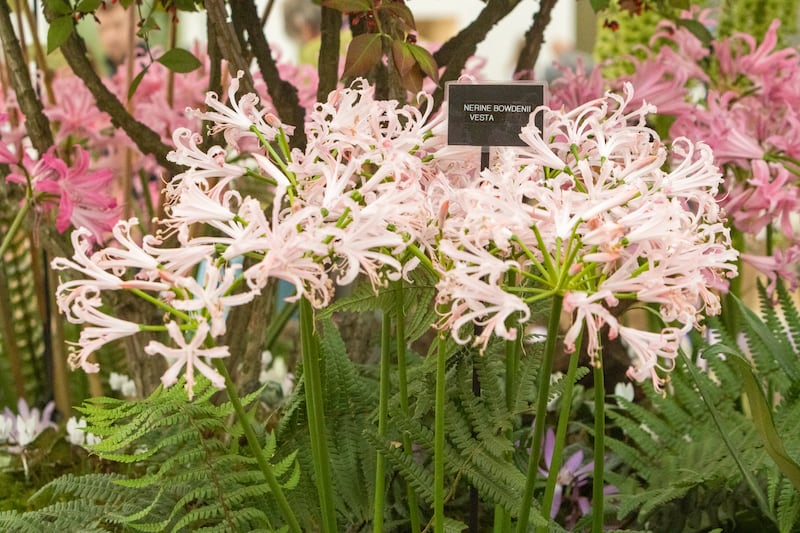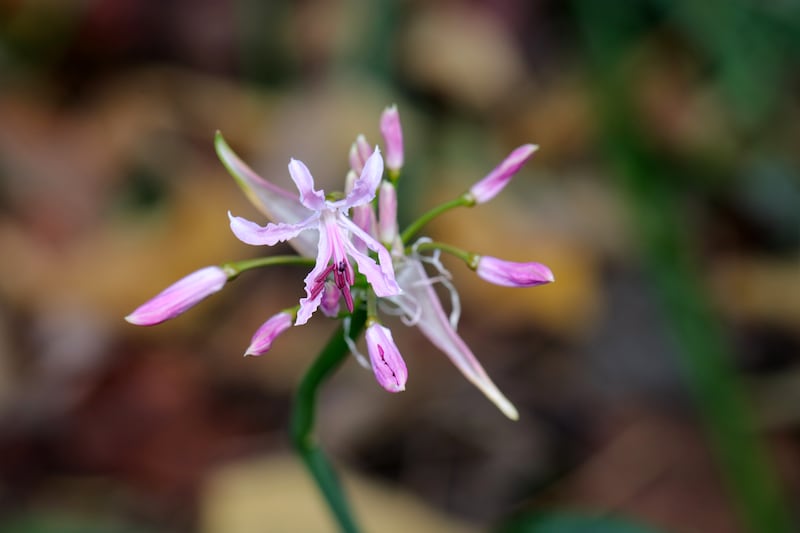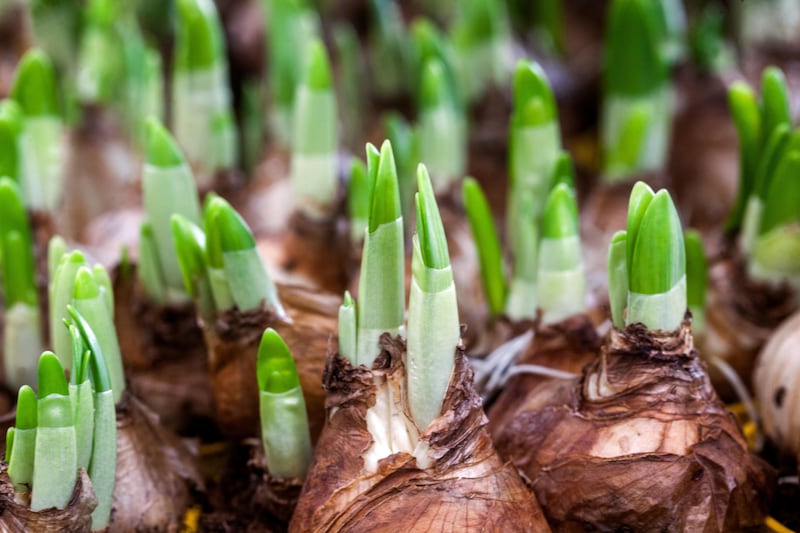Garden for long enough and you’ll eventually find yourself saying, “I used to …” rather a lot. Because just as it’s true of almost all other aspects of life, fashions inevitably change in the world of horticulture as things slowly but surely come in and out of vogue, causing us to look at certain plants with a fresh eye. For many years I used to, for example, loathe nerines (Nerine bowdenii), a member of the Amaryllidaceae family known for its Barbie-pink, spidery autumn flowers. Seen in the dull grey funk of an autumn day, this South African bulbous plant seemed all lip gloss, fake eyelashes and Botox, as out of place in an Irish garden as a plastic orchid.
But then, almost imperceptibly, something began to shift. Its showy blooms started to seem less gaudy, more joyful, less Diana Dors and more Marilyn Monroe. I found myself admiring them in old gardens where the fleshy bulbs had been planted decades previously and then left undisturbed so that every autumn the flowers formed eye-popping ribbons of electric colour.
I subsequently learned that nerines make outstandingly good, long-lasting cut-flowers. That as much as they love plenty of water in summer, they’re also drought-tolerant as well as brilliantly suited to container growing. That Nerine bowdenii and its sub-species — the hardiest nerine most suitable for growing outdoors in an Irish garden — was first introduced into Ireland at the very beginning of the 20th-century when the distinguished horticulturist William Gumbleton (such a wonderful name) grew it at Belgrove, his garden in Cobh, Co Cork.

Gumbleton, incidentally, was famous — or perhaps that should be infamous — for his intolerance of any plants that he deemed not garden-worthy, including plants growing on other people’s gardens, which he would summarily execute by spiking them with the sharp tip of his umbrella. But nerines made the grade, their exotic beauty appealing to his collector’s eye.
READ MORE
Gumbelton’s shocking-pink species aside (Nerine bowdenii), I also discovered that there are varieties with white flowers (Nerine ‘Athena’); soft pink flowers (Nerine ‘Vesta’); and bi-coloured flowers (the pale pink and white Nerine ‘Lipstick).
And then, most recently, I discovered the amarine, the nerine’s beautiful offspring that’s a result of a hybrid cross between it and another South-African bulbous member of the Amaryllidaceae family, Amaryllis belladonna. The latter’s species name “belladonna”, by the way, translates as “beautiful lady”, a reference to its large, striking, fragrant flowers.
As discerning as he was, I reckon that Gumbleton would have approved of amarines, which are like nerines on steroids. Bred with the cut-flower industry in mind, they’re taller than their nerine parent, as well as larger-flowered, more floriferous and longer-flowering with sturdier stems.
How best to grow them in Ireland? Both the nerine and the amarine’s hardiness is completely dependent on the bulbs being given a moist but very free-draining, fertile loamy soil in full sun, ideally with the shelter of a south- or west-facing wall behind them. These kinds of growing conditions allow the fleshy bulbs to gently bake on sunny summer days (something that nerines and amarines both love) as well as protecting them from rotting in cold, wet winter soil while they’re dormant below ground.

Rather like bearded irises (a plant that likes very similar growing conditions), nerines and amarines also like to be planted closely together (no more than 5cm) and shallowly, with the top of the neck of each bulb about 3cm above the finished surface of the soil. In their native South Africa, nerines grow in soil-filled crevices on steep, rocky mountainsides, a good indication of what’s needed to keep them and their beautiful hybrid offspring happy. So for extra insurance, it’s also always a good idea to work plenty of horticultural grit into the soil before planting and ideally to protect the bulbs with a deep, dry leafy mulch in winter.
But if the soil in your allotment or garden is heavy and naturally prone to winter wet, then the better bet is to grow them in a raised bed or in a pot or container. Container-growing not only helps to keep the emerging foliage safe from slug and snail damage but it also means that in very cold gardens if harsh frosts threaten the flowers in late autumn, then the plants can be temporarily moved under cover to protect them
Where to grow them? Their other-worldly, unicorn-like beauty and dislike of any kind of shade makes nerines and amarines tricky to place convincingly in a traditional Irish flower border. Instead, I think they look best as a solo act grown en-masse along the edge of a sunny, sheltered path or at the base of a hedge, glasshouse or sunny wall as described above, or in a large handsome pot or trough. But as long as their bulbs aren’t shaded out by other more leafy species, they can also look at home in a contemporary gravel garden grown alongside other sun-lovers such as ornamental sages, agapanthus and ornamental grasses, or in a sub-tropical, exotic style garden with large-leaved foliage plants.
When to plant them? Expert opinion varies as to the best time of the year to plant their fleshy bulbs. Some recommend late winter to mid-spring while others recommend mid-spring to mid-summer. Either way, if you have a glasshouse, polytunnel or a bright porch, you can get a head-start by starting them off under cover in a pot in the coming weeks and then moving them to their permanent position outdoors later this spring. At this time of year, you’ll find them for sale in good garden centres as well as online from specialist Irish suppliers such as mrmiddleton.com
Slow to get going, they rarely flower well in their first year, but once they’ve settled in, they’ll reliably flower their socks off each autumn, their blooming period triggered by the arrival of cooler autumn temperatures. Just make sure not to disturb established clumps other than to divide and replant them in early spring every four to five years, bearing in mind that they are both gregarious species that enjoy surprisingly cramped growing conditions.
Lastly, don’t forget to pick a few stems to enjoy indoors. Placed in simple glass bud vases along the centre of a table, their sculptural flamingo-pink flowers look extraordinary.
This week in the garden
Woody and perennial plants growing in pots and containers need special care if they’re to remain healthy and strong, as otherwise over time they can begin to suffer from a shortage of nutrients and cramped growing conditions. This is a good time of year to repot very established specimens that have outgrown their containers, as well as to top-dress others by removing the top 5cm of old, spent compost and replacing it with fresh compost.

As the new shoots of herbaceous perennials begin to push their way through the soil over the coming weeks, they become especially vulnerable to serious damage from slugs and snails so take careful precautions to keep the latter in check. Along with the use of organically acceptable slug pellets (sprinkle these lightly around the emerging shoots of very vulnerable species such as delphiniums and hostas), it’s important to practise good garden hygiene, encourage visiting garden birds and to keep weeds in beds and borders under control as these can act as a safe hiding place for slugs and snails.
Dates for your diary
Today, Saturday, February 25th (12pm-2pm and 2pm-4pm), Capparoe, Scariff, Co Clare, Irish Seed Savers Annual Community Seed Share event, a fantastic opportunity to share/swap seeds with other growers and gardener. This is a ticketed event with pre-booking via Eventbrite.ie recommended, see irishseedsavers.ie/blog
Also Saturday 25th February, 9am-5pm, RDS Hall 6, RDS, Ballsbridge, Dublin 4 (Anglesea Road entrance), Mr Middleton Flower Bulb/Rare Plant Spring Open Day, with an extensive range of summer-flowering bulbs, seed potatoes, and rare plants for sale including many new varieties, mrmiddleton.com














